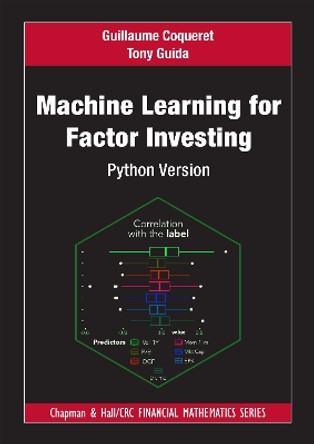Description
Machine learning (ML) is progressively reshaping the fields of quantitative finance and algorithmic trading. ML tools are increasingly adopted by hedge funds and asset managers, notably for alpha signal generation and stocks selection. The technicality of the subject can make it hard for non-specialists to join the bandwagon, as the jargon and coding requirements may seem out of reach. Machine Learning for Factor Investing: R Version bridges this gap. It provides a comprehensive tour of modern ML-based investment strategies that rely on firm characteristics.
The book covers a wide array of subjects which range from economic rationales to rigorous portfolio back-testing and encompass both data processing and model interpretability. Common supervised learning algorithms such as tree models and neural networks are explained in the context of style investing and the reader can also dig into more complex techniques like autoencoder asset returns, Bayesian additive trees, and causal models.
All topics are illustrated with self-contained R code samples and snippets that are applied to a large public dataset that contains over 90 predictors. The material, along with the content of the book, is available online so that readers can reproduce and enhance the examples at their convenience. If you have even a basic knowledge of quantitative finance, this combination of theoretical concepts and practical illustrations will help you learn quickly and deepen your financial and technical expertise.
About the Author
Guillaume Coqueret is associate professor of finance and data science at EMLYON Business School. His recent research revolves around applications of machine learning tools in financial economics.
Tony Guida is executive director at RAM Active Investments. He serves as chair of the machineByte think tank and is the author of Big Data and Machine Learning in Quantitative Investment.
Reviews
"This book is the perfect one for any data scientist on financial markets. It is well written, with lots of illustrations, examples, pieces of code, tips on the different statistical package available to perform the various algos. This book requires for sure a strong knowledge in quantitative finance and Machine Learning, so it cannot be put in any hands. But for those who are familiar with quantitative finance, this book can be a reference, as Hull's book is as regards to derivatives products. I liked the good and detailed analysis of the different Machine Learning algos, and the different examples used throughout the book. This book is perfect for assets managers having to run backtests and searching for innovative ways to enhance the return of their portfolios. I spent quite a good time reading this manuscript, and I would recommend it." (Frederic Girod, Union of European Football Associations)
"This book is the perfect one for any data scientist on financial markets. It is well written, with lots of illustrations, examples, pieces of code, tips on the different statistical package available to perform the various algos. This book requires for sure a strong knowledge in quantitative finance and Machine Learning, so it cannot be put in any hands. But for those who are familiar with quantitative finance, this book can be a reference, as Hull's book is as regards to derivatives products. I liked the good and detailed analysis of the different Machine Learning algos, and the different examples used throughout the book. This book is perfect for assets managers having to run backtests and searching for innovative ways to enhance the return of their portfolios. I spent quite a good time reading this manuscript, and I would recommend it."
-Frederic Girod, Union of European Football Associations
Book Information
ISBN 9780367545864
Author Guillaume Coqueret
Format Paperback
Page Count 342
Imprint Chapman & Hall/CRC
Publisher Taylor & Francis Ltd
Weight(grams) 839g





